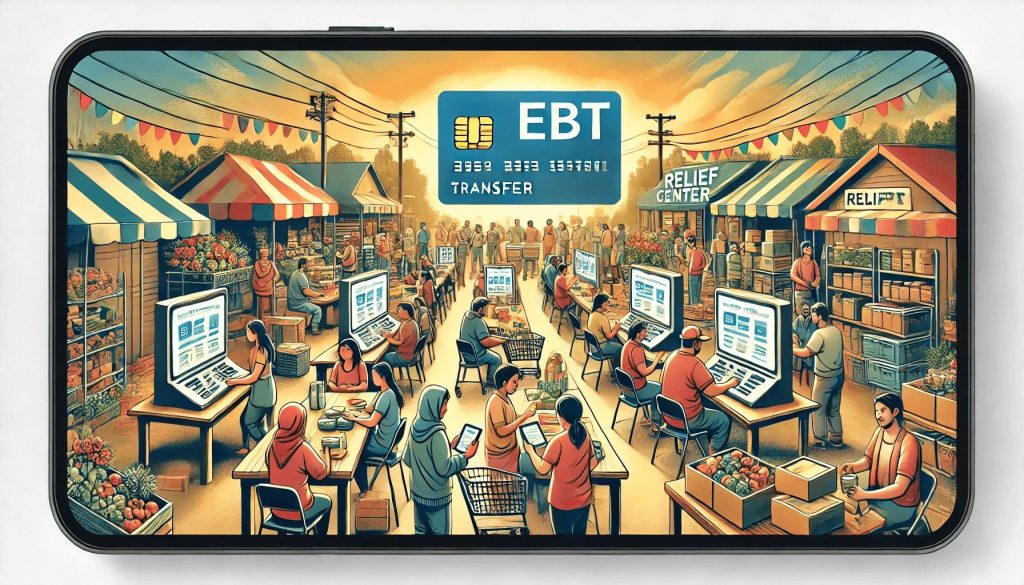
By manoj November 25, 2024
Disasters—whether natural, such as hurricanes, floods, and wildfires, or man-made, such as economic crises or wars—have devastating impacts on communities. The disruption of food supply chains, financial instability, and the displacement of vulnerable populations create an urgent need for efficient relief systems. One essential tool in disaster relief and recovery is the Electronic Benefits Transfer (EBT) system.
By providing seamless, secure, and rapid access to critical assistance, EBT plays a pivotal role in helping communities recover from crises. This article delves into the intricacies of EBT, its application in disaster relief, and its transformative potential.
Introduction
In the aftermath of a disaster, the ability to provide immediate and effective assistance is critical to saving lives and ensuring a path to recovery. Disasters often create widespread devastation, leaving individuals and families struggling to access basic resources. Relief efforts typically aim to address these needs, but traditional methods of aid distribution can be slow, inefficient, and prone to misuse.
The advent of Electronic Benefits Transfer (EBT) systems has revolutionized disaster relief. EBT allows governments and organizations to distribute aid digitally, bypassing many logistical hurdles. It ensures that vulnerable populations receive the help they need without delays, fostering greater accountability and transparency in the process.
The role of EBT is particularly significant in programs like the Supplemental Nutrition Assistance Program (SNAP) and its disaster counterpart, Disaster SNAP (D-SNAP). These programs provide critical food assistance to low-income individuals and families affected by emergencies, enabling them to purchase essentials with dignity and autonomy.
EBT is not just a convenience—it is a lifeline. By examining its functions, benefits, and challenges, this article highlights why EBT is an indispensable part of disaster relief and recovery.
What is EBT, and How Does It Work?
EBT is a digital system that governments use to distribute benefits to eligible recipients. Replacing traditional methods such as paper checks or food stamps, EBT cards function similarly to debit cards, enabling users to access benefits electronically.
Core Components of EBT
The effectiveness of EBT lies in its robust infrastructure, which integrates several critical components to ensure seamless operation. These components form the backbone of the system, enabling it to function reliably even during large-scale emergencies.
EBT Cards
Each recipient is issued a card linked to their benefits account. These cards are:
- Secure, with unique PINs for authorization.
- Convenient, allowing users to access funds at any authorized retailer or ATM.
- Durable, designed for repeated use over extended periods.
Point-of-Sale (POS) Systems
POS terminals are installed at participating retailers to process EBT transactions. These systems:
- Verify the recipient’s benefits eligibility.
- Ensure compliance with program rules (e.g., approved items for SNAP).
- Provide real-time transaction data to central benefit management systems.
Centralized Benefit Management
Government agencies use centralized systems to manage benefit distribution, monitor usage, and track expenditures. These systems:
- Automatically allocate funds to EBT accounts.
- Provide analytics to assess program efficiency.
- Maintain records for auditing and fraud prevention.
Authorized Retailer Networks
Retailers must meet specific criteria to accept EBT payments. These networks include:
- Grocery stores and supermarkets for SNAP purchases.
- ATMs and financial institutions for TANF cash withdrawals.
- Emergency distribution points in disaster-affected areas.
By combining these components, EBT systems create an efficient, secure, and scalable solution for distributing assistance during crises.
How EBT Functions in Everyday Scenarios
EBT is commonly used to distribute benefits under programs like:
- Supplemental Nutrition Assistance Program (SNAP): Provides food assistance to low-income individuals and families.
- Temporary Assistance for Needy Families (TANF): Offers cash benefits to help families meet basic needs.
The cardholder uses the EBT card at participating retailers to purchase approved items or withdraw funds. Transactions are automatically verified through a secure system, ensuring that benefits are used appropriately.
The Role of EBT in Disaster Relief

Disasters create a sudden and overwhelming demand for basic resources. Governments and relief organizations must act quickly to address the needs of affected populations. EBT systems play a pivotal role in these efforts by enabling rapid and targeted distribution of aid.
Immediate Response to Emergencies
EBT ensures that assistance reaches recipients within hours of activation, eliminating delays caused by traditional distribution methods. This is particularly critical in the initial stages of disaster response, where access to food, water, and other essentials can prevent further suffering.
Supporting Displaced Populations
In disasters that displace large numbers of people, such as hurricanes or wildfires, EBT cards can be used at authorized retailers across multiple locations. This flexibility ensures that displaced individuals can access resources wherever they are.
Reducing Logistical Bottlenecks
Traditional aid distribution often involves transporting and distributing physical goods, which can be challenging in disaster zones. EBT eliminates the need for these processes, streamlining relief efforts and reducing costs.
Activation of Disaster SNAP (D-SNAP)
One of the most significant applications of EBT in disaster scenarios is the activation of Disaster SNAP (D-SNAP). This program is specifically designed to provide emergency food assistance to households impacted by disasters.
Key Features of D-SNAP
- Expanded Eligibility: D-SNAP extends benefits to households that may not normally qualify for SNAP but are experiencing temporary financial hardships due to a disaster.
- Simplified Application Process: Applicants only need to demonstrate disaster-related expenses or loss of income, making it easier for affected families to access assistance.
- Temporary Benefits: D-SNAP provides short-term support, typically for one to two months, to help households recover.
How D-SNAP Works
Once a disaster is declared, state governments can request federal approval to activate D-SNAP. Eligible households receive a one-time allotment loaded onto EBT cards, which can be used to purchase food at participating retailers.
Benefits of EBT in Disaster Relief and Recovery

EBT systems offer numerous advantages over traditional methods of distributing aid, making them indispensable in disaster scenarios.
Speed and Efficiency
One of the greatest strengths of EBT is its ability to deliver benefits quickly. In disaster scenarios, where delays can exacerbate suffering, the ability to disburse aid within hours is a lifesaver.
Accessibility for Vulnerable Populations
EBT systems are user-friendly, ensuring that even individuals with limited technological skills can access benefits. This inclusivity is particularly crucial for elderly individuals, people with disabilities, and families with young children.
Fraud Prevention and Accountability
EBT systems significantly reduce the risk of fraud and mismanagement by maintaining a digital trail of all transactions. This ensures that benefits are used as intended and reduces administrative overhead.
Flexibility for Recipients
Unlike pre-packaged relief kits, EBT allows recipients to purchase items based on their specific needs, providing dignity and autonomy in their recovery process.
Adaptability to Various Programs
The EBT system is versatile, capable of supporting multiple assistance programs simultaneously, such as SNAP, TANF, and D-SNAP.
Challenges of EBT in Disaster Relief

While EBT systems have proven invaluable, they are not without limitations. Addressing these challenges is crucial to maximizing their effectiveness in disaster scenarios.
Infrastructure Dependency
EBT relies on functional power grids, internet connectivity, and telecommunications infrastructure—all of which are often disrupted during disasters. This can hinder the ability of recipients to access their benefits.
Limited Retailer Participation
Not all retailers accept EBT, particularly in rural or remote areas. This can restrict access to essential goods for populations in disaster zones.
Technological Barriers
While EBT is designed to be user-friendly, some recipients may face challenges, such as lack of familiarity with digital systems or difficulty understanding the process during high-stress situations.
Cybersecurity Risks
As a digital system, EBT is vulnerable to cyberattacks. Protecting recipient data and ensuring the integrity of the system is a constant challenge.
Future of EBT in Disaster Relief and Recovery
As disasters become more frequent and severe, the need for innovative and resilient relief systems is greater than ever. EBT systems have the potential to evolve and address emerging challenges in disaster response.
Technological Advancements
Emerging technologies, such as blockchain, mobile apps, and offline-capable systems, can enhance the security, efficiency, and accessibility of EBT systems. These advancements will allow benefits to be distributed even in areas with compromised infrastructure.
Pre-Disaster Planning
Governments can improve disaster preparedness by identifying vulnerable populations in advance and pre-loading benefits into EBT systems. This proactive approach ensures immediate support when disasters strike.
Expanded Retailer Networks
Increasing the number of retailers that accept EBT, particularly in underserved areas, will improve access to essential goods for disaster-affected populations.
Integration with Other Relief Programs
EBT systems can be integrated with housing, healthcare, and financial assistance programs, providing a comprehensive safety net for disaster victims.
Public-Private Partnerships
Collaborations with financial institutions, technology providers, and retailers can expand the reach and resilience of EBT systems, ensuring uninterrupted access to benefits during crises.
FAQs
Q.1: What is the difference between SNAP and D-SNAP?
SNAP is a long-term food assistance program for low-income individuals, while D-SNAP provides temporary food assistance to households affected by disasters.
Q.2: How do I apply for D-SNAP benefits?
Applications for D-SNAP are typically handled by state agencies. The process is simplified during disasters to ensure rapid assistance.
Q.3: Can EBT cards be used in areas without internet or electricity?
Standard EBT transactions require internet and power. However, advancements in offline-capable systems are being developed to address this limitation.
Q.4: What can EBT benefits be used for?
EBT benefits are primarily intended for purchasing food. However, cash assistance programs, like TANF, allow for broader use, including purchasing non-food items or paying bills.
Q.5: How does EBT prevent fraud?
EBT systems use secure digital tracking and authentication measures to monitor transactions, ensuring that benefits are used appropriately.